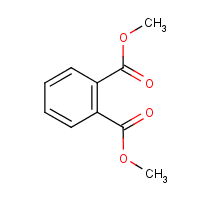Dimethylphthalate
Agent Name
Dimethylphthalate
CAS Number
131-11-3
Formula
C10-H10-O4
Major Category
Plastics & Rubber

Synonyms
1,2-Benzenedicarboxylic acid, dimethyl ester; Avolin; DMF (insect repellant); DMP; Dimethyl 1,2-benzenedicarboxylate; Dimethyl benzene-o-dicarboxylate; Dimethyl benzeneorthodicarboxylate; Dimethyl o-phthalate; Dimethyl phthalate; Dimethylester kyseliny ftalove [Czech]; Fermine; Mipax; NTM; Palatinol M; Phtalate de dimethyle [ISO-French]; Phthalic acid dimethyl ester; Phthalsaeuredimethylester [German]; Repeftal; Solvanom; Solvarone; Unimoll DM; [ChemIDplus] UN3082
Category
Phthalate Esters
Description
Colorless, oily liquid with a slight, aromatic odor; Note: A solid below 42 degrees F; [NIOSH]
Sources/Uses
Plasticizer (added to polymers to effect flexibility and/or toughness); also used as a solvent and insect repellant; [ACGIH]
Comments
Ingestion can cause central nervous system depression. Used as a mosquito repellant during World War II, no skin sensitization was reported. DMP is a possible animal teratogen. [ACGIH] In high-dose reproductive studies of rats and mice, DEHP and other phthalates cause testicular damage to males and increased fetal losses and malformations to pregnant females. [Frazier, p. 350-2] The abstract to the article "Occupational contact dermatitis caused by computer mice" can be found in NIOSHTIC # 202472. One worker was patch test positive to dimethylphthalate and one to diethyl phthalate. [Reference #1] Not irritating to the skin based on human and animal information; [CHEMINFO] No listed effects of short-term or long-term exposure; [ICSC]
Restricted
No longer registered for pesticide use; [HSDB]
Biomedical References
Exposure Assessment
Skin Designation (ACGIH)
Insufficient data
TLV (ACGIH)
5 mg/m3
PEL (OSHA)
5 mg/m3
IDLH (NIOSH)
2000 mg/m3
Excerpts from Documentation for IDLHs
The revised IDLH for dimethylphthalate is 2,000 mg/m3 based on acute inhalation toxicity data in animals [Eller 1937]. [Note: Due to its low volatility, this concentration could only be reached at elevated temperatures or if the liquid droplets become airborne as in a mist.]
Vapor Pressure
0.0031 mm Hg
Lethal Concentration
LCLo (cats) = 9,630 mg/m3/6H
Explanatory Notes
Flash point = 146 deg C;
Reference Link #2
NFPA
must be preheated
Adverse Effects
Skin Sensitizer
Yes
Reproductive Toxin
Yes
Diseases, Processes, and Activities Linked to This Agent
Diseases
Occupational diseases associated with exposure to this agent: